Groucho Glasses
I never understood why the article described as “Groucho glasses” was associated with Groucho, since I never saw much of a resemblance. So I decided to see what I could find out.
In “Cheap Laffs: The Art of the Novelty Item” (a 2004 book) author Mark Newgarden mentions a number of types of novelty glasses including “BEAGLE PUSS AKA Big Nose & Glasses, The Beak, Mr. Beak, Mr. Schnozz, Schnozola, 4 – Piece Schnozola, Groucho Goggles, Groucho Specs, Snoopy Puss, Mustachio Mr. Beak.”
Things seem to have begun in the spring of 1950. “Billboard” from 18 March 1950 had ads selling a nose and glasses combo (no mustache) as “Mr. Beak” and described as “sweeping the country” and “The New Look for 1950.” One ad was pairing the glasses with a comic derby-style felt hat.

Interestingly, “Billboard” from 4 Feb 1950 had an ad for “Mr. Beak” (“The real new look for 1950”), in an ad that also featured “Marx Bros.’ Rubber Masks” which I assume were timed to coincide with the release of “Love Happy” in October 1949.

In late 1950 the “4 Piece Schnozola” appeared. It consisted of “a pair of plastic spectacles, a moustache, eyebrows and a large flesh colored nose” as per an ad in the back of “Real Detective” magazine in December 1950 and a similar one in the 1951 “Catalogue of E-Z Magic.” So, pretty much today’s Groucho glasses but with no mention of the Groucho name.
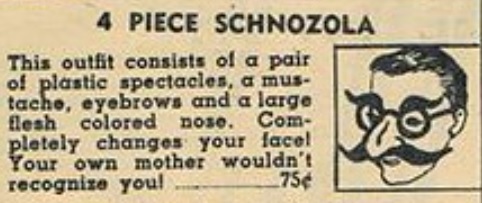
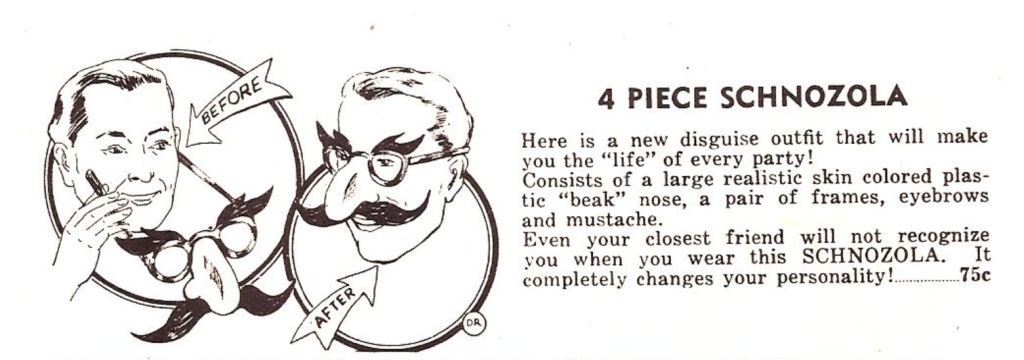
By 1951 the “schnozzola” disguise was well enough known that the glasses came up in the court case “Ppl of the State of NY against Calman Cooper et al” in 1951 as exhibits 19 and 20.
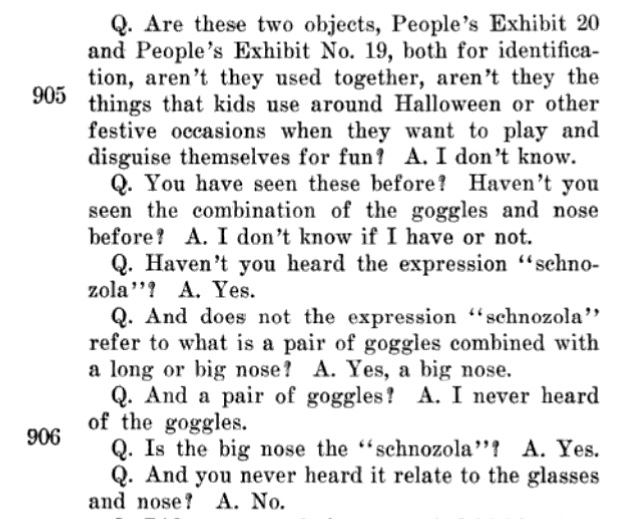
Just in time for Halloween 1954 something called “Groucho Goggles” came on the market. Made by Eldon Mfg. of Los Angeles, these came with a cigar, made a wolf whistle, and had eyes that would whirl.
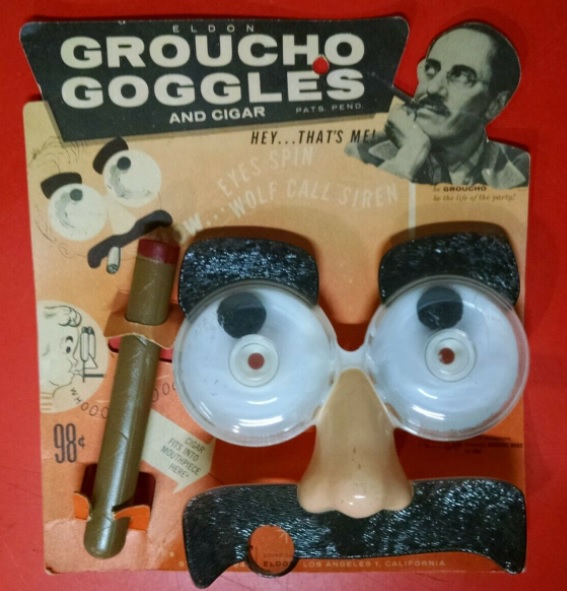
There was also a “You Bet Your Life” game in in 1955 that came with individual glasses, eyebrows, mask, and cigar so that you could look like the quizmaster while playing.

“Groucho glasses” as describing the thing we all think of as Groucho glasses really only dates to about the time of Groucho’s death, as far as I can tell looking at historic newspapers.
In the mid 1970’s the Franco-American Novelty Co. began producing the classic looking glasses under the name “Beagle Puss Disguise Kit”.

Google has a feature called Ngram Viewer that allows you to plot uses of a word or phrase overtime using the books Google has scanned in Google Books. If you search for “Groucho glasses” you can see that the phrase was not really used (in books) at all until right around Groucho’s death. After that the usage explodes, as can also be seen in newspaper article that begin at that time to describe the classic glasses as “Groucho glasses.”

It appears that in order to capitalize on the Beagle Puss / Groucho connection that had organically developed, Groucho Marx Enterprises put out its own authorized fuzzy moustache and eyebrows model starting in the early 2000’s.
So it seems that they were a non-Groucho related item in the early 1950’s, first without mustache and then with.
Then an independent Groucho-specific model came out in the mid-1950’s.
Then the modern non-Groucho model (fuzzy moustache type) came out in the mid-1970’s around the time of Groucho’s death. And that model just started getting called “Groucho glasses” in popular culture, possibly because of the recent death of Groucho. It doesn’t seem as though there was ever an intentional attempt to associate the glasses with Groucho until Groucho Marx Productions put out their own line not too long ago.
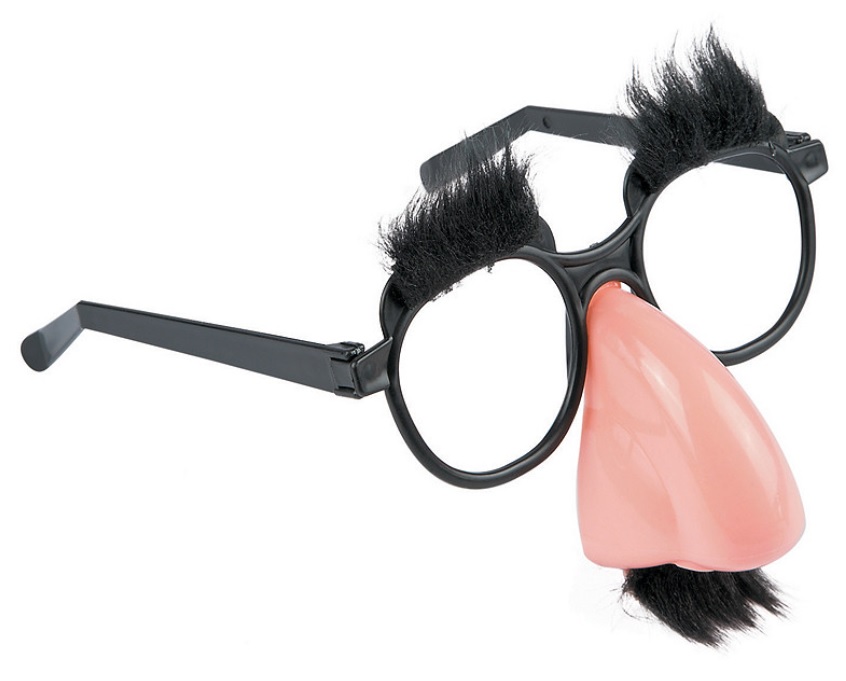
The Gookie
I decided to dive in and see if I could find the original cigar-rolling Mr. Gookie.
In the end, my thought is that there was no “Mr. Gookie”, just someone with a normal name we’ll never be able to track.
In the 1900 Federal census there are a little over 250 males whose last name starts with “Go” or “Gu” in Manhattan with some form of “cigar” as occupation. But nothing close to “Gookie”. And if I go into wider and wider variants I wouldn’t know if I got the right guy or not.
The face seems to be originally identified under the name “Gooky” by Kyle Crichton in his book The Marx Brothers in 1951. Harpo then mentions it in Harpo Speaks in 1961.
Harpo says Gookie was in a store window on Lexington Avenue that was a neighborhood social club of sorts. In the 1902 Manhattan business directory I found a cigar store at 1414 Lexington, all of 350 feet from the Marx house. It was also mentioned as a polling place that was a cigar store in the New York Times of 1908. There are no other cigar stores particularly close, so I’m pretty confident that was where Gookie’s window was.

I also found a picture of the corner (SW corner of 93rd and Lexington) in 1940, which may or may not be the original building. The tax records say it was built in 1910 but those records are known to be a bit off.
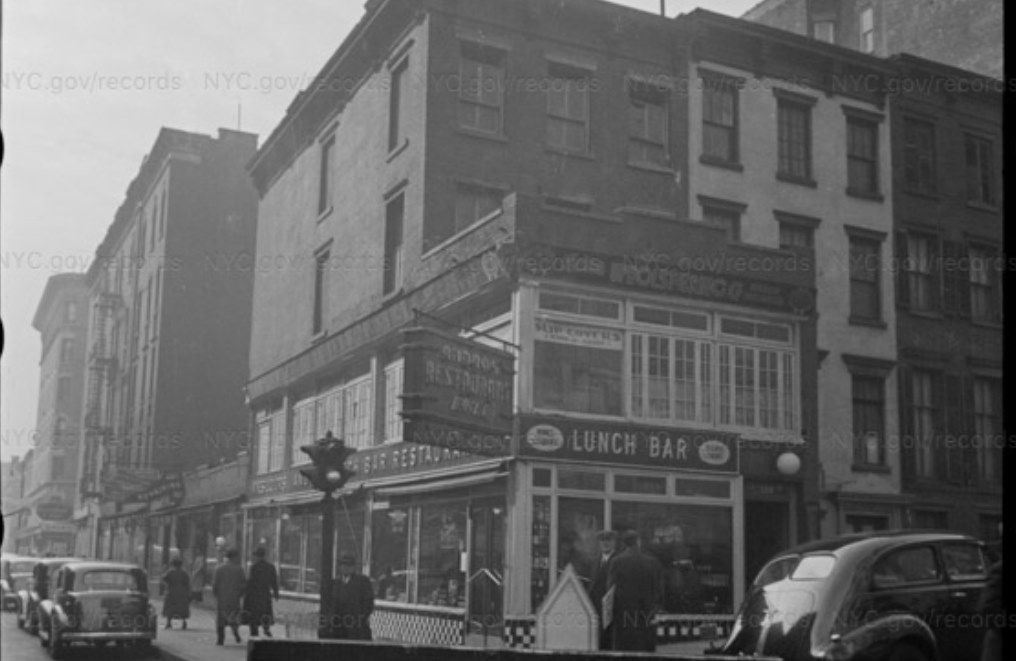
And for a Marxian connection, who did I catch crossing at that corner towards Gookie’s window in February 1956? Marilyn Monroe.
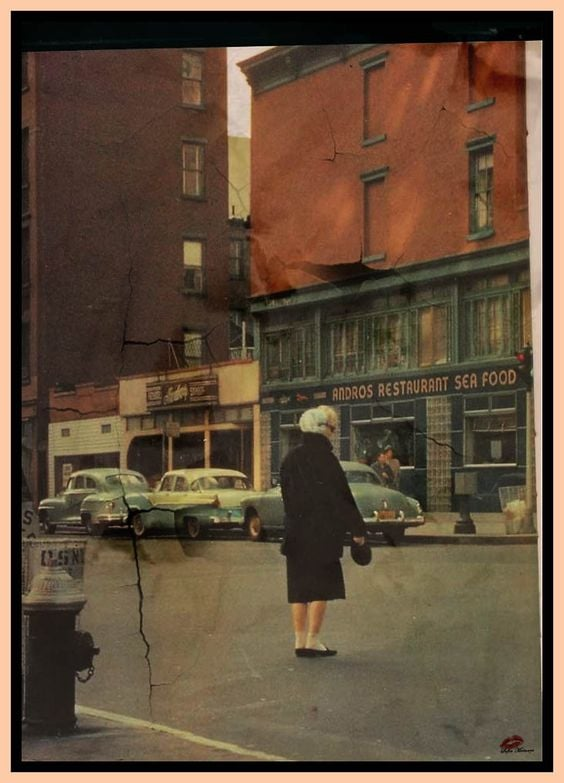
You never know who you’ll meet on the street in Manhattan.
Harpo describes Gookie with considerable detail so I believe the story. It’s just the word “Gookie” that’s a sticking point. But I may have found a clue on that.
For a few weeks in May and June 1904 the New York Evening World newspaper ran a series of comics about a creature named “The Gook” who would show up and make people feel “gooky.” The gook was cross-eyed and honked a horn, at least.

Harpo says he started throwing Gookies when he was 12, which would be 1901 or so. So it’s close. Groucho was essentially named for a comics character, why not the Gookie?

Being Paid In Pennies
While looking through “Groucho and Me” I came across the story of the boys being paid in pennies and thereby causing a theater to burn down.
Since I’m living in Illinois (Land of Lincoln) I dug into the penny story.
“Groucho and Me” says it happened right before Christmas and that Chico and Gummo were in the act. That narrowed things to 1912-1917. And that the manager had once fought heavyweight boxing champ Tommy Burns to a draw. There were only nine of those.
Then I wasted some time because, although the manager was an ex-boxer, he was actually Jack Root, who is believed to be the first light heavyweight champ. Root’s name came up when Groucho told the story in Hello, I Must Be Going.
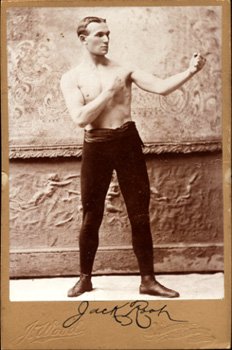
Root was the owner and manager of the Garrick Theater in Burlington, Iowa. “Mr. Green’s Reception” played the Garrick Dec. 19–22, 1912. And on February 11, 1913 the Garrick, yes, had fire.
But it didn’t burn down.
Until it did.

On Oct. 26, 1930, when it was the Rialto.
The George Mercer (not Murphy) mentioned in the newspaper had bought the theater from Root in November 1912 so I’m not sure we can completely know if Root was the penny man.
In both versions Groucho say it was $900.
90, 000 pennies, at 2.5 grams to the penny, is 496 lbs. And would be about two cubic feet of penny.
In a weird little coda, when “Home Again” played in Buffalo in Jan. 1917 Chico’s character was referred to as “Tony Caponi” in the paper. And Tommy Burns did fight a Tony Caponi to a draw in March 1904.
Miss Flatto
I went diving to find Harpo’s 2nd grade teacher at P.S. 86, Miss Flatto, but came up slightly confused. So this is for those of you who enjoy useless endeavors with inconclusive results.
Harpo says he was in her class in his second go-round of 2nd grade. Also that Alexander Woollcott found her, and that they were all planning a tea date “the day you get back from Muscovy” but she died while Harpo was in Russia (Nov. 1933-Jan. 1934). Woollcott himself died in Jan. 1943.
That tea date makes some sense as Harpo was living in California and Woollcott lived in New York, so a tea date after Harpo sailed back into New York is logical.
Harpo was born in November 1888. New York had a December 1st birthday cutoff to start school so he should have started 1st grade at 5 in September 1894 right before he turned 6. So he’d start 2nd grade in September 1895, and repeat the grade starting September 1896.
Using resources mostly from Google Books and http://www.hathitrust.org I found a Miss Agnes Blatt who began teaching in February 1897 as a substitute. So she could have subbed with Harpo for the spring of his second run at 2nd grade. In October 1897 she was assigned to P.S. 61, but by 1901 she was at (back at?) P.S. 86. She dies in 1970. I assumed that she was the right person and that Harpo changed her name and then said she was dead to protect her.
But then I was informed about an actual Flatto, Miss Sarah Flatto, graduating Teacher’s College in June 1895. I can’t find her teaching in school year 95-96 (Harpo’s first year of 2nd grade, when she should have her first teaching job). But for Harpo’s second year of 2nd grade (1896-97) she’s on a list of substitute teachers on 10 Sep 1896 and then assigned to P.S. 75 on 24 Sep 1896, then assigned to P.S. 7 on 24 Dec 1896, then on 7 Jan 1897 is assigned to P.S. 35. The next year she’s at P.S. 135 where she stayed until 1899. She married in 1902 and died in 1952.
I’ve looked at “The City Record,” a NYC publication that every January published the names and assignments of all teachers. There’s no Flatto listed on staff for the years 1895-1897. Sarah Flatto first shows up in “The City Record” in January 1898, at P.S. 135, for school year 1897-1898.
I also found a 3 May 1900 listing for her where she’s attached to P.S. 30 and her time of service given at 3 year and 6 months. So 3 Nov 1896. This trues with her not teaching anywhere during Harpo’s first stab at 2nd grade and then teaching elsewhere during his second. Unless “time of service” starts when you’re no longer subbing and actually assigned.
The only way she fits Harpo is if she taught him his first year of 2nd grade (school year 1895-1896) in an assignment I can find no record of. For his second year in 2nd grade, school year 1896-1897, she’s at schools 75, 7 and 35 from September on.
Turns out she’s not the one, the only, Flatto, either. There’s a Miss Sadie Flatto who got her teaching license on 15 Oct 1903 and taught at P.S. 82 and P.S. 83. She died in 1959.
I assume that Woollcott really found her. While he knew Harpo, of course. So 1925-1943.
That Flatto death date of late 1933 is oddly specific. If you’re going to lie and write “she died’ you don’t need to specify a six-week window. And it’s odd that none of them died before Woollcott, who seems to have been alive when she died.
I’ve looked into a few stories from “Harpo Speaks” and his memory is usually pretty good. He fudged dates to appear younger, but the facts are solid.
I warned you at the beginning that it was going to be inconclusive.

Lou Levy
Early in their vaudeville career Groucho, Harpo, and Gummo sang with a boy named Lou Levy as the Four Nightingales. No one knows what happened to Lou after he left the act, so I decided to see what I could find.
Here he is on the bottom.
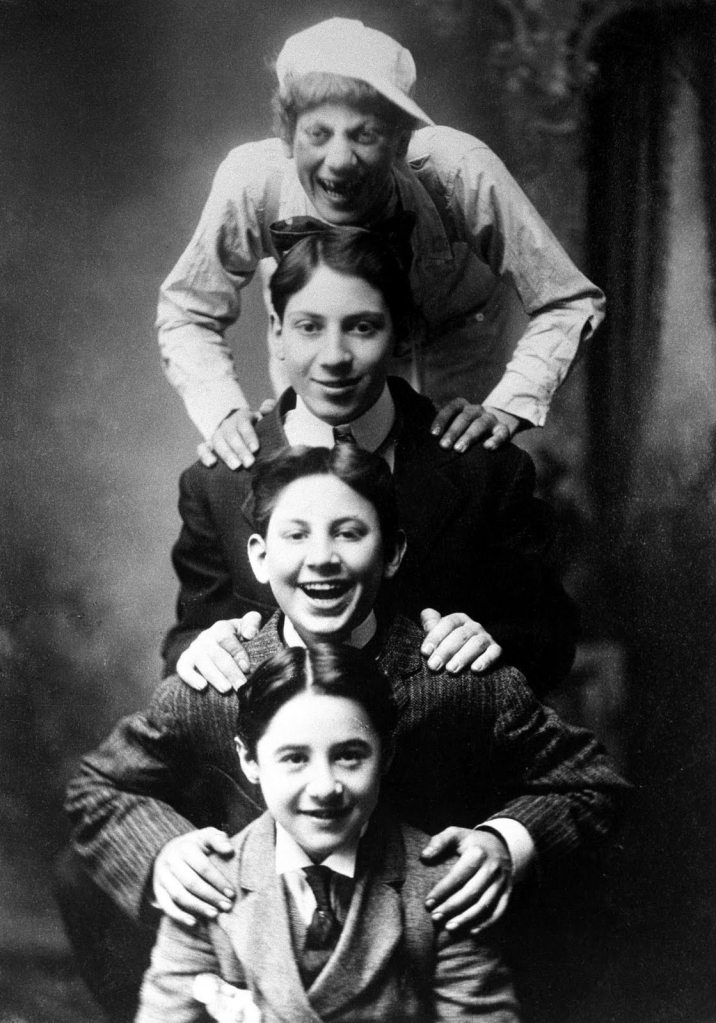
First, here’s what we know about Lou.
He was slim, from Brooklyn, and had a good voice. He was in the Nightingales act from spring 1908 to about May 1909 (right after Nacogdoches). In pictures he looks to be about 13 (thus born about 1895).
There. We’re done with the facts.
In a 1942 newspaper column, Damon Runyon says that Harpo says that Lou eventually weighed about 250 pounds. If true, it shows that Harpo had some connection to Lou, however minor, once Lou became an adult.
Now we’re really done with the facts.
All my digging turned up what I’d say is one honest original nugget about actual Lou.
The September 1909 edition of “Variety” mentions a “Louis Levy, baritone” playing the Arcade Theater in Newark. So he took a shot as a solo singer a couple months after the Nightingales, it seems.
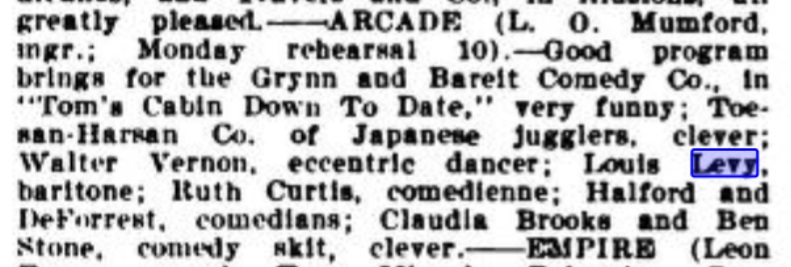
Robert Bader in “Four of the Three Musketeers” makes the case for a Lou Levy who was in Brooklyn in the 1910 census.
I agree. And I’ve fleshed that case out. But it’s all speculation, so I’ll just lay out what I found about that particular Lou.
That Lou was born to Siegmund and Sarah (Reifer) Levy on 9 Sep 1895 at 497 E Houston.
In that 1910 census there are two Levy parents, nine Levy kids, and a mother-in-law. Having a baby every year makes tracking movements easy. They moved to Brooklyn from Manhattan in about 1906.
Groucho says Lou Levy was from Brooklyn.
Here’s a photo of Siegmund, the father and three of his oldest sons, on the left. I believe Lou is on the far left.
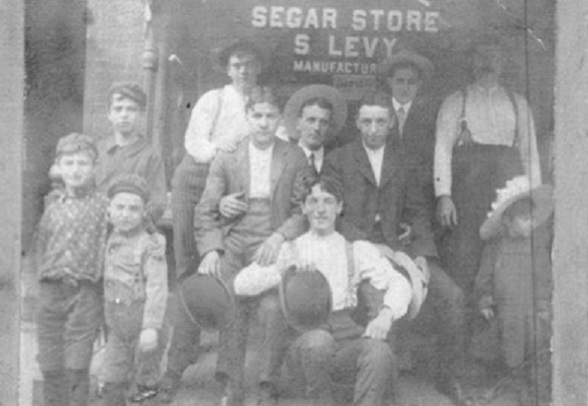
In that 1910 census the oldest son, Jacob (Jack) was 21 and a theater manager. Son Louis is marked as 18, but it looks like a 15 turned into an 18 -and the 1895 birthdate is consistent in future censuses. He’s a bookkeeper in a theater.
In the 1915 New York state census both he and brother Abraham are booking agents. Booking films I think, not talent.
Jack is living separately and is a theater manager.
There’s a good blurb about Jack from “Motion Picture News” from 1915 that mentions that in 1904 he was in the Barnum and Bailey Circus doing a juggling and slackwire act.

So then when potential Lou was thinking of entering the lower end of show business in 1908 he already had an older brother who was there before him and who had worked in theaters for a few years. And who had been working for Fox films for a year when Lou joined the Nightingales.
In the 1920 census Jack is a film salesman. In city directories in 1917-18 Lou’s working as a film booker for Universal Films, living a 43 Lorimer in Brooklyn. It was his job for the next dozen years.
In 1916 Lou Levy of that address married Paula Heilbronne Frank.
In 1917 he registered for WWI using 22 Jul 1893 as a birthday.
In 1919 Lou applied for a passport to go to Brazil to work as a representative of Universal. The passport included a photo of 25 year old Lou. His name is changed to Lew Levy, a spelling he’d use for the rest of his life.

The 18 Sep 1929 “Film Daily “ says that Louis J. and Jack Levy have formed the Theater Acoustics Corp. Happily it includes brief bios of both. Louis “for many years was with Universal in a sales capacity” while Jack was “branch manager for Fox” but more recently with Phototone.
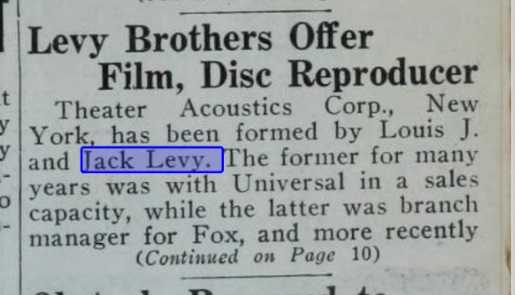
All the info I found on Jack was from trade journals basically charting his movements with Fox and independent ventures, all the motion picture distribution field. Typical is a 1912 blurb mentioning his jumping from United Theater Picture Productions to National Picture Corporation. Whenever there was a convention he was mentioned in the small print. Pretty much the same for Louis, who I found mentioned in blurbs over the years as attached to Universal. (He’s not the Lou Levy who worked for Universal in Des Moines. Don’t fall into that trap. And he’s not the Lou Levy who, in the 1940 census, was living with his cousin Milton Stern, who would go on to be the stage manager for the original national tour of “Kiss Me Kate,” having recently married actress Janet Medlin, and recently fathered Veronica Stern. Veronica would go on to a minor acting career, be the step-daughter of Barry Levinson, have a fling with Paul Stanley of KISS, break up with him, and then commit suicide shortly after. Ah, rabbit holes.)
So Louis Levy came up in a family that had some previous entertainment business experience. Then he and his brother Abraham followed brother Jack into the film business (booking films for theaters, it seems) in the 20’s and 30’s.
I found Jack in the 1950 census when he’s living in Queens as a film salesman for the motion picture industry. And he’s living with his wife Annabelle, whom he divorced in 1917 but never left. (“She changed physicians just as often as she changed her hat which, according to the bills paid by me, was about once a month.”)
He appears in the trades until 1956. Being 67 at that point he may have just retired.
A Jack Levy died in Queens on 23 Mar 1958 and that may be him.
The only other interesting tidbit is a photo of Jack in 1955 where he’s shown to be quite a heavy man. Giving slight credence, perhaps, to Damon Runyon’s mention of him being 250 pounds.
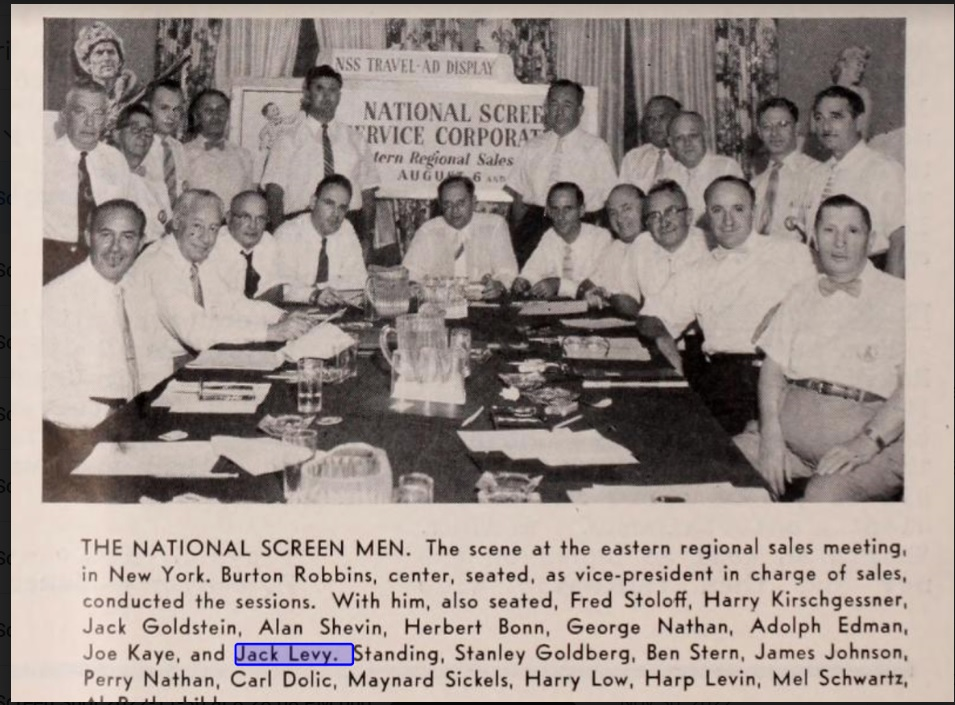
In the 1940 census Lewis J and Paula Levy are living in Newark.
In the 1950 census Paula is in Miami Beach listed as “married” but Lew isn’t enumerated. He’s in Miami Beach telephone directories in 1949 and 1950, neither Ley there in 1951. Then the next directory I could see had Paula there alone, where she remained until she died in 1980.
So I assume Lou died in Miami Beach between 1951 and 1955.
So there you go. No claim of having definitively found Nightingale Lou Levy. Just some facts about a candidate who may have more claim to having been in vaudeville as a child than any other candidate.